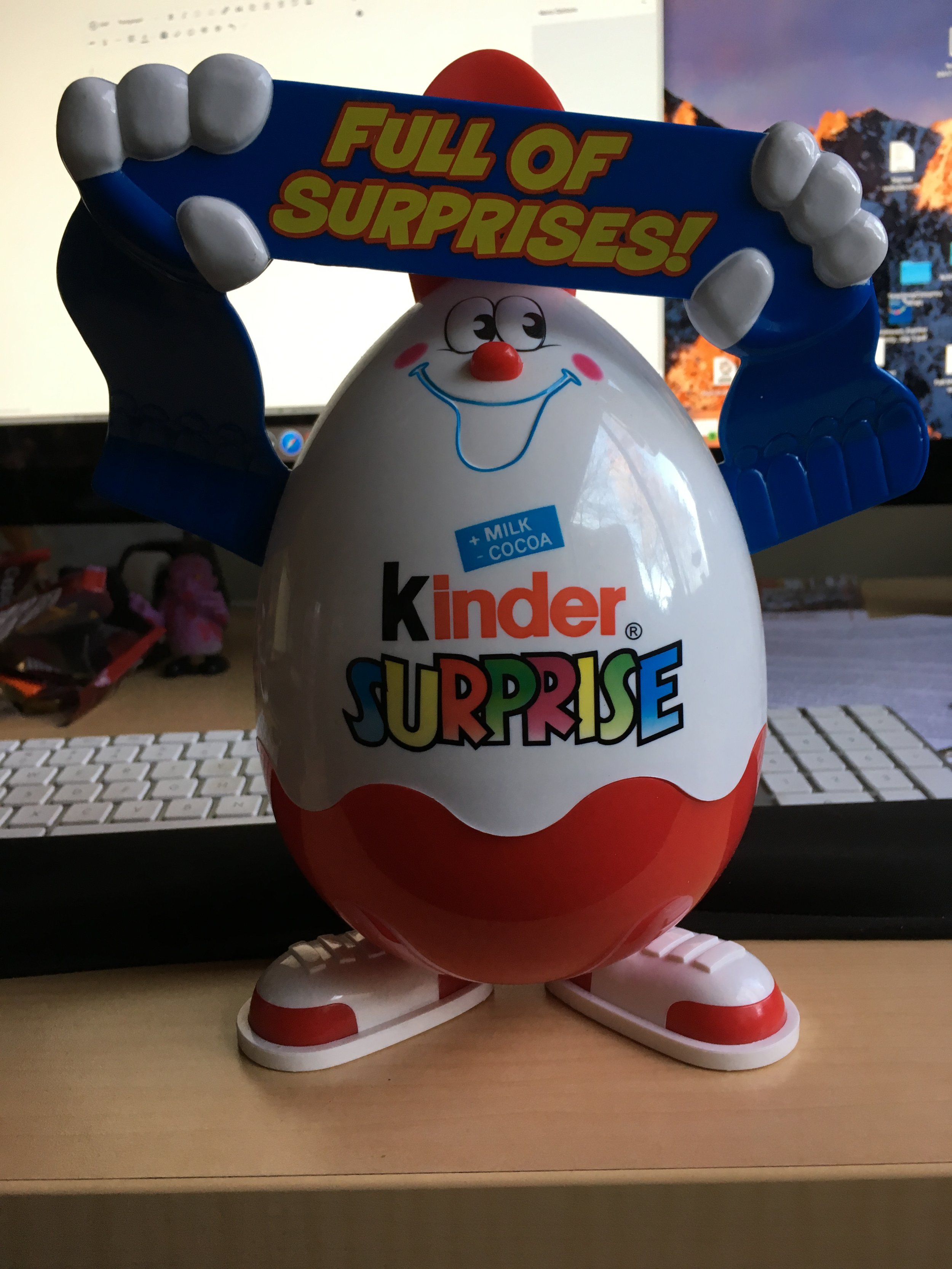The Engines of Nonfiction: Kindling Surprise
This thing is a large plastic container I bought in the duty free section of a German airport on the way home from my aunt's funeral a few years ago. My mom was with me, shaking her head and laughing at this most irrational purchase. It was FILLED with my most favorite candy, called in German a Kinder Überraschungs-Ei, or surprise egg. You unwrap the chocolate egg and crack it open, and inside each egg is a toy that is usually a million times better than a Cracker-Jack surprise, though I think you technically can't buy these in the US because they have tiny parts that someone might swallow (if they were to SOMEHOW UNHINGE THEIR JAWS and swallow something that is the size of a real egg. Anyway. I am still able to buy them in the US but I won't reveal my source.)I am bringing this to class today to talk about that piece of advice attributed to Robert Front that comes up often in writing classes: "No surprise in the writer, no surprise in the reader." We read to discover, and the creation of that feeling of discovery is kindled best when it happens first for the writer, when the writer puts something together on the page that they didn't expect to encounter.But, as I am a writing teacher, I need to say more than this. So how do we go about surprising ourselves?Then... because I never studied geography, I feel free to use three layers of the earths crust as a metaphor.
You unwrap the chocolate egg and crack it open, and inside each egg is a toy that is usually a million times better than a Cracker-Jack surprise, though I think you technically can't buy these in the US because they have tiny parts that someone might swallow (if they were to SOMEHOW UNHINGE THEIR JAWS and swallow something that is the size of a real egg. Anyway. I am still able to buy them in the US but I won't reveal my source.)I am bringing this to class today to talk about that piece of advice attributed to Robert Front that comes up often in writing classes: "No surprise in the writer, no surprise in the reader." We read to discover, and the creation of that feeling of discovery is kindled best when it happens first for the writer, when the writer puts something together on the page that they didn't expect to encounter.But, as I am a writing teacher, I need to say more than this. So how do we go about surprising ourselves?Then... because I never studied geography, I feel free to use three layers of the earths crust as a metaphor.
- Juxtaposition: This is the "top layer" of surprise in an essay, the stuff we can see on the surface. Anytime we can put two seemingly unrelated things next to each other, that creates the energy and tension that can surprise the reader. I'm teaching Lidia Yuknavitch's beautiful essay "Woven" today in class, and I think her movement back and forth between this vivid myth and her own life story provides the energy to move the piece forward and also to make the reader never really sure where the author will go next. And I'm betting that Yuknavitch felt the same way when she was writing it, full of surprise herself as the myth in all its details illuminated elements of her own experience.
- Association: But how do you find something to juxtapose with a story from your life or something that happened? This is where the poetry muscle of association comes in, going one level deeper in excavating how surprise works. Rather than using logical connections, you have to sometimes settle down and really watch your mind. What seemingly bizarre images or memories are triggered when you write about a certain topic? What do you feel in your body and mind when you are confronting a topic? Why, when I smell crayons, do I think of road trips, and what does that mean? Why does a print of a painting I have in my office remind me of my dad's face? In each case, you take the leap into a feeling of not being exactly sure where you are going. Rather than controlling the narrative and making a logical case, you are leaping into the way your mind really works, and there are things to discover if you take that risk. If I then sit down to write about all the connections that might come up between crayons and the time in the car during my childhood, I am definitely going to surprise myself because I don't know at all what those connections mean.
- Self-Interrogation: Ultimately, the deep layer of nonfiction that creates surprise every day in writing is to always have a voice in the background that asks, "But what does that mean? Why do you think that way? Is it really true all the time? Where does that belief come from? Why do you remember it like that? How would someone else feel in your shoes? Why do you like or dislike that? What does this connect to? What is invisible here?...." And on and on. And all those questions are bound to take us somewhere that was never apparent at the beginning of an essay.